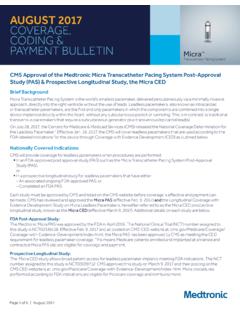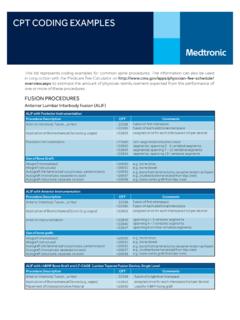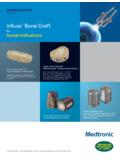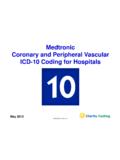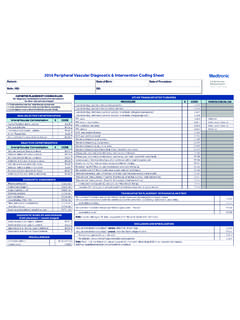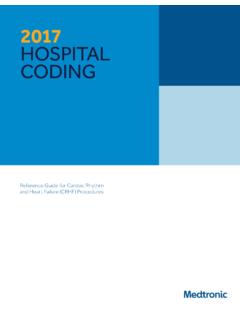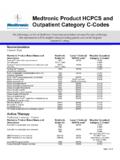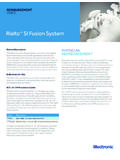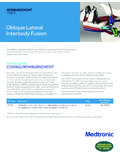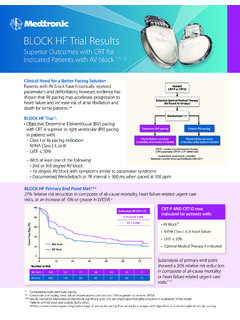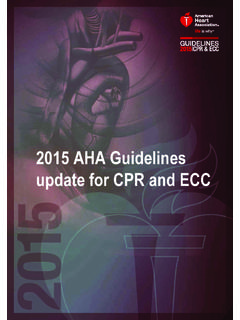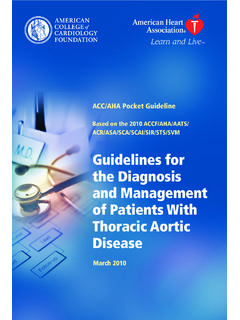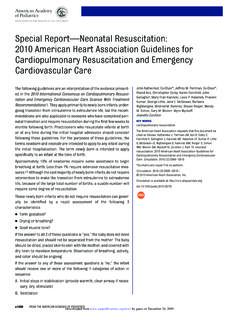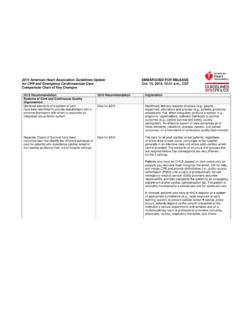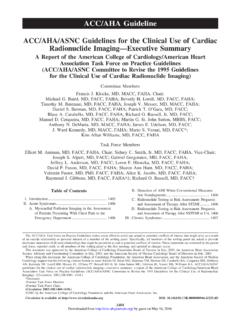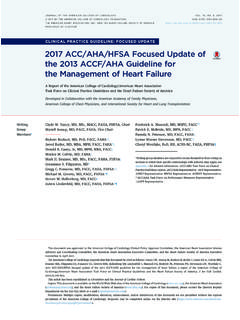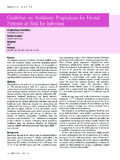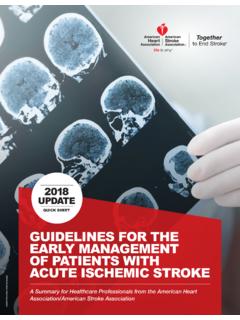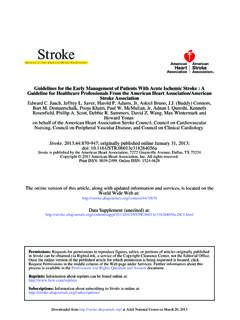Transcription of 2015 INTERNATIONAL GUIDELINES ON CPR: …
1 In 2015, the american Heart association (AHA) released an update to the 2010 AHA GUIDELINES for Cardiopulmonary Resuscitation (CPR) and Emergency Cardiovascular Care (ECC). The new document focused on topics with significant new science or ongoing controversy, and serves as an update to the 2010 GUIDELINES rather than a complete remains an emphasis on the use of capnography for adults and pediatrics, expressly validating the value and significance of waveform capnography in saving lives and stressing the critical importance of waveform capnography to confirm and monitor endotracheal tube placement, assess the quality of CPR, and detect return of spontaneous circulation (ROSC).The new update includes additional clinical utility for capnography that builds on the current 2010 Recommendations for Capnography to be incorporated into Advanced Cardiac Life Support GUIDELINES and Pediatric Advanced Life Support GUIDELINES .
2 These additional usages in the adult population include1: Adequacy of chest compressions Potential indicator to end resuscitative efforts in adults Endotracheal tube placement1,2In regards to additional recommendations for the use of capnography in pediatric patients, the 2010 Pediatric Advanced Life Support Guidelines6 included use of capnography to confirm endotracheal tube placement. The 2015 GUIDELINES have now additionally recommended the use of capnography to1,2: Assess CPR quality while resuscitation is in progress Limit patient exposure to hypo- and hypercapnia2 2015 INTERNATIONAL GUIDELINES ON CPR: RECOMMENDATIONS FOR CAPNOGRAPHYA dult Advanced Cardiovascular Life Support (ACLS) Recommendations Adjuncts to CPRThe AHA ACLS Task Force evaluated the available clinical evidence to determine whether using feedback from monitoring physiologic parameters to guide CPR quality improved survival and neurologic outcome.
3 As a result, one of the major changes in the AHA 2015 Advanced Cardiac Life Support GUIDELINES includes recommendations about the future prognosis of the patient based on exhaled CO2 chapter: Part 7: Adult Advanced Cardiovascular 3 Although no clinical study has examined whether titrating resuscitative efforts to physiologic parameters during CPR improves outcome, it may be reasonable to use physiologic parameters (quantitative waveform capnography, arterial relaxation diastolic pressure, arterial pressure monitoring, and central venous oxygen saturation) when feasible to monitor and optimize CPR quality, guide vasopressor therapy, and detect ROSC (Class IIb, LOE C-EO). 3 Management of Cardiac ArrestThe 2015 INTERNATIONAL Liaison Committee on Resuscitation (ILCOR) systematic review considered one type of monitoring to be used during arrest, etCO2 measurement, for indicating an outcome related to cardiac arrest.
4 During a cardiac arrest, etCO2 levels reflect the cardiac output generated by chest compressions. When a patient is found to have less than 10 mm Hg for an etCO2 value after 20 minutes of resuscitation, this has been associated with an extremely poor chance of ROSC and chapter: Part 7: Adult Advanced Cardiovascular Life Support 3 In intubated patients, failure to achieve an ETCO2 of greater than 10 mm Hg by waveform capnography after 20 minutes of CPR may be considered as one component of a multimodal approach to decide when to end resuscitative efforts but should not be used in isolation (Class IIb, LOE C-LD). 3 In nonintubated patients, a specific ETCO2 cutoff value at any time during CPR should not be used as an indication to end resuscitative efforts (Class III: Harm, LOE C-EO). 3 Adjuncts for Airway Control and VentilationThe 2015 ILCOR evidence review evaluated methods of confirming tracheal tube placement during CPR.
5 This review is related to the fact that attempts at endotracheal intubation during CPR have been associated with unrecognized tube misplacement or displacement as well as prolonged interruptions in chest compressions. In addition to listening to the lungs and stomach, several methods have been proposed, including waveform capnography to confirm successful endotracheal tube placement in adults during cardiac chapter: Part 7: Adult Advanced Cardiovascular Life Support 3 Continuous waveform capnography is recommended in addition to clinical assessment as the most reliable method of confirming and monitoring correct placement of an ETT (Class I, LOE C-LD). 3 Pediatric Advanced Life Support (PALS) and Neonatal ResuscitationThe use of PALS typically takes place in an organized setting such as an advanced healthcare environment. Resuscitation teams will most likely have access to patient monitoring that may provide additional information during the performance of basic life CareHigh quality CPR is associated with improved outcomes post cardiac arrest.
6 Capnography is used during pediatric cardiac arrest to monitor for ROSC as well as CPR chapter: Part 12: Pediatric Advanced Life Support 4 ETCO2 monitoring may be considered to evaluate the quality of chest compressions, but specific values to guide therapy have not been established in children (Class IIb, LOE C-LD). 4 Chest CompressionsGuideline chapter: Part 13: Neonatal Resuscitation 5 The current measure for determining successful progress in neonatal resuscitation is to assess the heart rate response. Other devices, such as end-tidal CO2 monitoring and pulse oximetry, may be useful techniques to determine when return of spontaneous circulation occurs. However, in asystolic/bradycardic neonates, we suggest against the routine use of any single feedback device such as ETCO2 monitors or pulse oximeters for detection of return of spontaneous circulation, as their usefulness for this purpose in neonates has not been well established (Class IIb, LOE C-LD).
7 5 Postarrest CareAfter ROSC in children, cerebral autoregulation may be abnormal. Data from adults shows an association between post-ROSC hypocapnia and worse patient outcomes. Other types of pediatric brain injuries demonstrate hypocapnia to be associated with worse clinical outcomes. Additionally, some evidence shows hypercapnia to be associated with worse survival to hospital chapter: Part 12: Pediatric Advanced Life Support 4 It is reasonable for practitioners to target a Paco2 after ROSC that is appropriate to the specific patient condition, and limit exposure to severe hypercapnia or hypocapnia (Class IIb, LOE C-LD). 4 ConclusionThe new 2015 GUIDELINES from the AHA for CPR and ECC continue to validate the value and significance of waveform capnography in guiding patient care and interventions. The AHA recommends capnography to confirm and monitor endotracheal tube placement, assess the quality of CPR, and detect ROSC, and help guide end-of-life efforts in adults.
8 Additional use in pediatric patients includes assessing CPR quality and helping clinicians avoid risk to patients of exposing them to hypo- or hypercapnia. By using capnography according to the AHA and ERC GUIDELINES , clinicians can be assured they are providing evidence-based recommendations to improve of all recommendationsPartTopicRecommendationCo mmentsPart 7: Adult Advanced Cardiovascular Life SupportAdjuncts to CPRA lthough no clinical study has examined whether titrating resuscitative efforts to physiologic parameters during CPR improves outcome, it may be reasonable to use physiologic parameters (quantitative waveform capnography, arterial relaxation diastolic pressure, arterial pressure monitoring, and central venous oxygen saturation) when feasible to monitor and optimize CPR quality, guide vasopressor therapy, and detect ROSC (Class IIb, LOE C-EO).Updated in 2015 Part 7: Adult Advanced Cardiovascular Life SupportAdjuncts for Airway Control and VentilationContinuous waveform capnography is recommended in addition to clinical assessment as the most reliable method of confirming and monitoring correct placement of an ETT (Class I, LOE C-LD).
9 Updated in 2015 Part 7: Adult Advanced Cardiovascular Life SupportManagement of Cardiac ArrestIn intubated patients, failure to achieve an ETCO2 of greater than 10 mm Hg by waveform capnography after 20 minutes of CPR may be considered as one component of a multimodal approach to decide when to end resuscitative efforts but should not be used in isolation (Class IIb, LOE C-LD).New for 2015 Part 7: Adult Advanced Cardiovascular Life SupportManagement of Cardiac ArrestIn nonintubated patients, a specific ETCO2 cutoff value at any time during CPR should not be used as an indication to end resuscitative efforts (Class III: Harm, LOE C-EO).New for 2015 Part 12: Pediatric Advanced Life SupportIntra-arrest Care UpdatesETCO2 monitoring may be considered to evaluate the quality of chest compressions, but specific values to guide therapy have not been established in children (Class IIb, LOE C-LD).New for 2015 Part 13: Neonatal ResuscitationChest CompressionsThe current measure for determining successful progress in neonatal resuscitation is to assess the heart rate response.
10 Other devices, such as end-tidal CO2 monitoring and pulse oximetry, may be useful techniques to determine when return of spontaneous circulation occurs. However, in a systolic/bradycardic neonates, we suggest against the routine use of any single feedback device such as ETCO2 monitors or pulse oximeters for detection of return of spontaneous circulation as their usefulness for this purpose in neonates has not been well established (Class IIb, LOE C-LD). (Class IIb, LOE C-LD).New for 2015 Part 1: Executive Summary, 2015 GUIDELINES Update: Master List of RecommendationsRespiratory SystemMonitor exhaled CO2 (PetCO2), especially during transport and diagnostic procedures (Class IIa, LOE B).Not reviewed in 2015 Part 1: Executive Summary, 2015 GUIDELINES Update: Master List of RecommendationsInterhospital TransportMonitor exhaled CO2 (qualitative colorimetric detector or capnography) during interhospital or intrahospital transport of intubated patients (Class IIa, LOE B).
